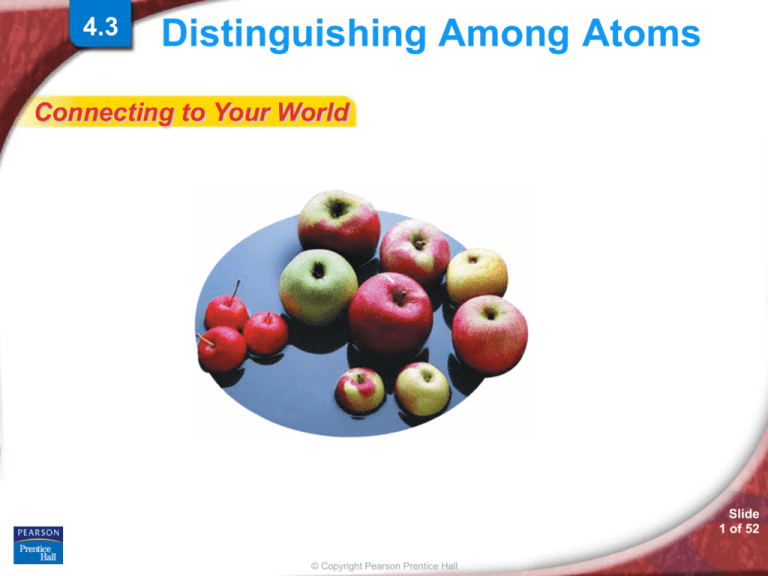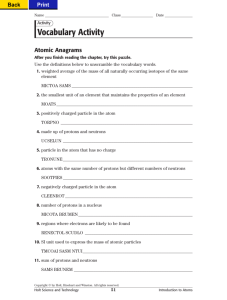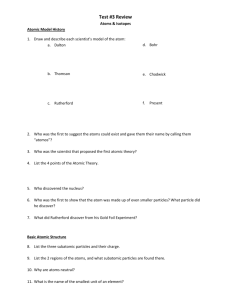
4.3
Distinguishing Among Atoms
Connecting to Your World
Slide
1 of 52
© Copyright Pearson Prentice Hall
4.3
Distinguishing Among Atoms
>
Atomic Number
Atomic Number
What makes one element different from
another?
Slide
2 of 52
© Copyright Pearson Prentice Hall
4.3
Distinguishing Among Atoms
>
Atomic Number
Elements are different from one another
because they contain different numbers
of protons.
Atomic Number= The number of protons
an element has. (It is the small whole
number in the periodic table.)
Slide
3 of 52
© Copyright Pearson Prentice Hall
Slide
4 of 52
© Copyright Pearson Prentice Hall
Slide
5 of 52
© Copyright Pearson Prentice Hall
4.3
Distinguishing Among Atoms
>
Mass Number
Mass Number
How do you find the number of neutrons in
an atom?
Slide
6 of 52
© Copyright Pearson Prentice Hall
4.3
Distinguishing Among Atoms
>
Mass Number
The total number of protons and neutrons in an
atom is called the mass number.
The number of neutrons in an atom is
the difference between the mass
number and atomic number.
Slide
7 of 52
© Copyright Pearson Prentice Hall
4.3
Distinguishing Among Atoms
>
Mass Number
Au is the chemical symbol for gold.
Mass number
Atomic number
Slide
8 of 52
© Copyright Pearson Prentice Hall
SAMPLE PROBLEM 4.1
Slide
9 of 52
© Copyright Pearson Prentice Hall
Distinguishing Among Atoms
>
for Sample Problem 4.1
Slide
10 of 52
© Copyright Pearson Prentice Hall
4.3
Distinguishing Among Atoms
>
Isotopes
Isotopes
How do isotopes of an element differ?
Slide
11 of 52
© Copyright Pearson Prentice Hall
4.3
Distinguishing Among Atoms
>
Isotopes
Isotopes are atoms that have the same number
of protons but different numbers of neutrons.
Because isotopes of an element have
different numbers of neutrons, they
also have different mass numbers.
Slide
12 of 52
© Copyright Pearson Prentice Hall
4.3
Distinguishing Among Atoms
>
Isotopes
Isotopes: Chemically alike because have same
number of protons and electrons. Only the
number of neutrons is different.
Slide
13 of 52
© Copyright Pearson Prentice Hall
Writing chemical symbols of isotopes:
Carbon-12 or 12C : both mean the
carbon isotope with a mass number
of 12.
Slide
14 of 52
© Copyright Pearson Prentice Hall
Distinguishing Among Atoms
>
for Conceptual Problem 4.2
Problem Solving 4.20
Solve Problem 20 with the help
of an interactive guided tutorial.
Slide
15 of 52
© Copyright Pearson Prentice Hall
4.3
Distinguishing Among Atoms
>
Atomic Mass
Atomic Mass
How do you calculate the atomic mass of an
element?
Slide
16 of 52
© Copyright Pearson Prentice Hall
4.3
Distinguishing Among Atoms
>
Atomic Mass
An atomic mass unit (amu) is defined as one
twelfth of the mass of a carbon-12 atom.
It is the unit used for atomic mass.
Slide
17 of 52
© Copyright Pearson Prentice Hall
4.3
Distinguishing Among Atoms
>
Atomic Mass
The atomic mass of an element is a weighted
average mass of the atoms in a naturally
occurring sample of the element.
A weighted average mass reflects both the mass
and the relative abundance of the isotopes as
they occur in nature.
Slide
18 of 52
© Copyright Pearson Prentice Hall
4.3
Distinguishing Among Atoms
>
Atomic Mass
Weighted Average Mass of a Chlorine Atom
Slide
19 of 52
© Copyright Pearson Prentice Hall
Slide
20 of 52
© Copyright Pearson Prentice Hall
4.3 Section Quiz
1. Isotopes of an element have
a. the same mass number.
b. different atomic numbers.
c. the same number of protons but different
numbers of neutrons.
d. the same number of protons but different
numbers of electrons.
Slide
21 of 52
© Copyright Pearson Prentice Hall
4.3 Section Quiz
2. How many neutrons are in sulfur-33?
a. 16 neutrons
b. 33 neutrons
c. 17 neutrons
d. 32.06 neutrons
Slide
22 of 52
© Copyright Pearson Prentice Hall
4.3 Section Quiz
3. If sulfur contained 90.0% sulfur-32 and 10.0%
sulfur-34, its atomic mass would be
a. 32.2 amu.
b. 32.4 amu.
c. 33.0 amu.
d. 35.4 amu.
Slide
23 of 52
© Copyright Pearson Prentice Hall












